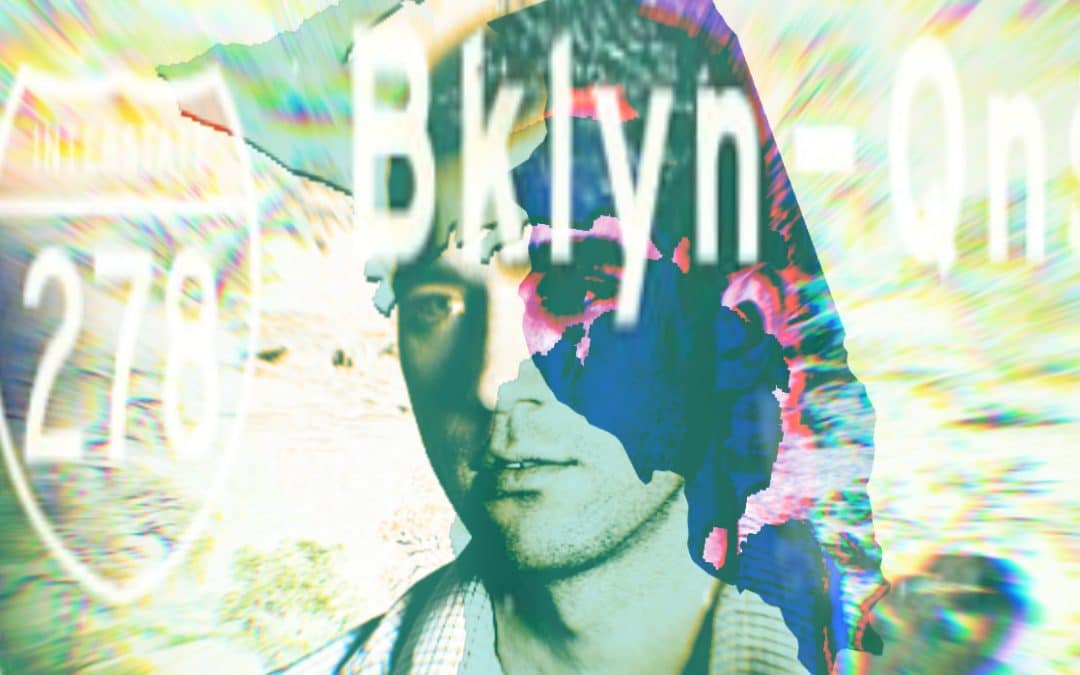EXPLORATIONS: SONIC HIGHWAYS

Corey Bell, Stage Traveler & Blogger
Wandering Prairie Fire:
Sufjan Stevens as Site-Specific Songwriter
Part VII of
Sonic Highways: Musical Immersion on the Roads of America
Always been a shoe made for the city…
Rufus Wainwright (one of my very favorite songwriters EVER) coos a plethora of beautifully penned lyrics throughout his magnanimous catalog of tunes, though that one in particular has always resonated with me, ever since I heard it for the first time back in 2003. Even though I was just an awkward sixteen-year-old prep school kid with only a learner’s permit and a B- in Honors Spanish III to keep him warm at night, those words spoke to me the very first time I heard “Cigarettes and Chocolate Milk” (he also has a line about walking drunk down 5th Avenue in flip-flops, but that’s for a different kind of essay). Feeling angsty and teenage-y and sick of my provincial life, I felt an unspoken kinship to those words, fantasizing about my future fabulous life away from Connecticut, among the twinkling spires of New York or San Francisco. Don’t get me wrong, I love occasional escapes to the country and I absolutely love being out in nature, but for the most part, when it comes to actual living conditions, urban environments are the kind that I feel most comfortable in.
Cities provide something that is not often found in the suburbs or rural areas that stretch out like spiderwebs all across America, and that’s a sense of cultural and geographical unity, Growing up in a small town in Connecticut, I often felt that there was a lack of communal pride and unity. Don’t get me wrong, I loved growing up where I did; that small town will always hold a special place in my heart. But at the same time there was a noticeable lack of the sense that we were all bound together, apart from the quasi-excitement we felt when the community fund surpassed its initial goal or when proud fathers would gather at Hubbard Field to cheer on their sons and daughters at little league games. As a child I often traveled to Boston and New York (they were both basically equidistant from where I grew up), and during those visits I noticed a vibrant sense of togetherness I hadn’t seen anywhere else. Even just being on the subway, I felt there was an unspoken respect amongst the preoccupied locals on the train, as if to say, We’re living in New York and we’re making it work. Go us!
Maybe it’s because larger cities like Boston and New York have things like sports teams to unite people, or they have experienced some great tragedy that makes being a citizen of that city somewhat of a struggle, as these people have seen great horrors in their lives yet still somehow persevere. I remember visiting NYC mere months after the terrorist attacks on the World Trade Center, and everyone that passed by had a great deal of sadness behind their eyes. It would only flash for a second or two before the fiery determination to press on and live bubbled up inside them, engulfing their despair in intermittent bursts, the tears retreating to seek shelter behind such brave facades. This kind of brave determination always struck me as incredibly admirable, and though the pain of 9/11 would never truly die, New York—almost instinctually, it seems—banded together in a tacit fit of desperate rage, as if to say, Y’all fucked with the WRONG city. Even as the last bits of rubble have been swept away and a new World Trade Center has risen like a phoenix from the ashes, unspoken whispers echo through the city streets and subway tunnels, forming a formidable web throughout the city and all her countless devotees.
When I was living in New Orleans, I always heard about “the storm,” an obvious reference to Hurricane Katrina, the unexpected cyclone that devastated the gulf coast and indirectly caused great flooding in New Orleans due via a faulty levee system. I remember watching it all happen on TV the day I arrived at Fordham University in Lincoln Center, as one of my four roommates happened to hail from the Big Easy. He watched his hometown get swept away, and the sheer horror in his face haunts me to this day. In the past several years, however, the city has bounced back remarkably, seeing its first pre-Katrina tourism revenues since the storm during the Superbowl in 2013, which was held at the Superdome and happened to coincide with the annual Mardi Gras celebration. One often encounters the same sort of horror hidden by a brave face walking around New Orleans, yet I feel that the collective unity is far more tangible than that which is felt in New York. To be clear, I am not diminishing the effect that 9/11 had on New Yorkers, nor am I questioning the universal esteem New Yorkers seem to have for one another; New Orleans just has a way different attitude than most cities. Many people suffered when Katrina hit, and repairs to the infrastructure of the city—as well as home repairs—are ongoing. I volunteered multiple times with organizations across the city to aid in reconstruction, one home at a time, and even in the most crime-ridden neighborhoods (there is a lot of gang violence in New Orleans) all I received was gratitude. Instead of anger and determined tenacity one might encounter in cities like New York, New Orleans emits a beacon of charity, mutual respect, and gratitude. These people are just happy to be alive. They hold no anger, and not because it’s basically futile to be mad at nature. They simply remain optimistic that they’ll get back on their feet. It’s just part of their culture to act and think positively, and more often than not, the people there really do care about each other.
Cities have a tendency to stick together and cultivate pride, even outside the lens of tragedy. Cities across the country—across the world, even—are places where people gather in great numbers to experience something. Things like environment, history, and cultural anomalies are huge factors in what makes a city unique. These different aspects feed into a sense of identity that those who populate such cities latch proudly onto. Many people yearn to discover their true identity, and cities provide a significant amount of cultural identity. Talk to anybody living in a major city and they more often than not can’t wait to tell you about the coolest things to do, or the best restaurants to eat at, or that one thing that you have to do while in town. And it doesn’t stop there.
Many cities—American cities, at least—have at least one “claim to fame”, whether it be Philadelphia’s cheesesteaks, Miami’s sandy beaches, Beverly Hills’ Rodeo Drive, or New Orleans’ drive-thru daiquiri shops (yes, they exist). These are the things that visitors flock to and the locals can’t stop yapping about. Music also plays a very important part in defining a city’s unique culture. Urban environments are prime real estate when it comes to music, as many cities in the USA reflect. New Orleans is often referred to as the birthplace of jazz, as the genre of jazz draws from several different cultural roots, including those pertaining to Afro-Cubans brought to the southern states during slavery and the boom of sugarcane trading, as well as Creole mentality as New Orleans quickly became one of the first settlements to establish a population of educated free blacks who were classically trained in Anglicized classical music. The union of these different cultures—in addition to a somewhat defiant attitude towards white classical musicians—brought about a heavily syncopated, improvisational form of music we now call jazz. In more recent years, troubled neighborhoods in New York and Los Angeles brought about the rise of rap and hip-hop, drawing heavy influence from feelings of oppression and, in some cases, gang warfare, to create an aggressive yet extremely expressive form of music. Even some electronic music found its birth in the states, drawing from influences ranging from disco to Motown that were met with an upswing in technology that made electronic instruments more accessible. Although most electronic music styles came from the UK and beyond, Detroit and Chicago became known for the rise of the techno and house movements, respectively. It’s no real surprise that environment played a major part in the syntheses of these types of music, and residents of these cities still hold true to these kinds of musical identities.
But since environments and attitudes have an effect on how we hear certain music, it’s safe to say that said environments and attitudes attribute to the creative process as well. Very often musicians and poets alike draw incredible amounts of influence from their surroundings, as evident in the works of Robert Frost and the musical stylings of Boards of Canada, both of whom use(d) natural environments as inspiration. Many folk musicians often sing about stories related to certain places and times, but I wanted to get a more specific and more contemporary/relatable perspective on the matter, so I turned my attention to another one of my favorite artists: a man by the name of Sufjan Stevens.
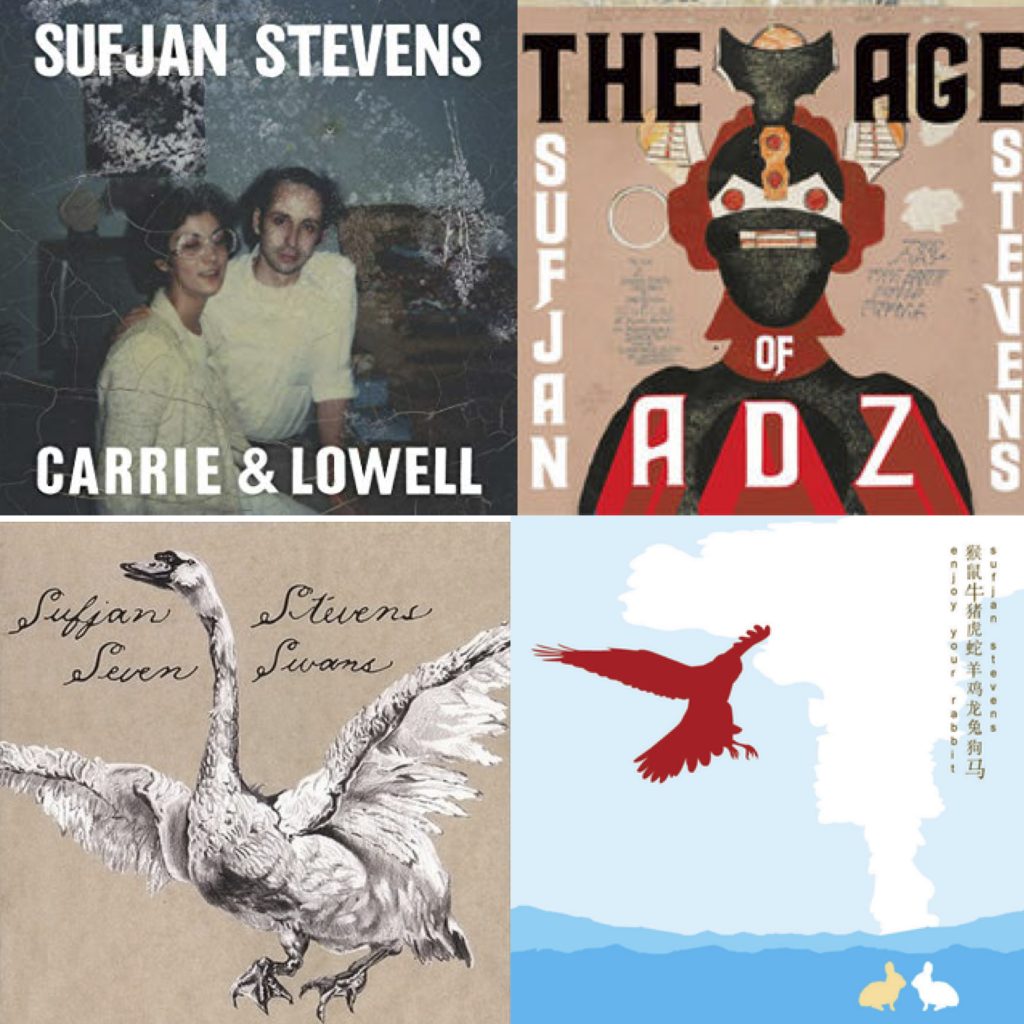
Some of Stevens' albums, clockwise from top left: Carrie & Lowell (2015), The Age of Adz (2010), Enjoy Your Rabbit (2002), and Seven Swans (2004).
Sufjan Stevens’s music over the past fifteen years or so has taken on so many forms it is nearly impossible to pin a specific genre to his Gucci lapel. His debut album, A Sun Came, was the result of a semester-long journey of self-discovery in college, as he experimented with several different instruments and mediums. Since then he has helmed and recorded an incredible array of projects, including a bonkers 10-disc Christmas collection (with possibly more on the way???), a delicate acoustic-driven ode to love and Christianity (Seven Swans), an electronic instrumental album based on the Chinese zodiac (Enjoy Your Rabbit), and his most recent release, 2015’s Carrie & Lowell: a painful, gorgeous stripped-down tribute to his late mother and step-father. Recently he has gone back to the electronic medium as a principal contributor to Planetarium, a magnum opus celebrating our solar system and beyond through collaboration with Bryce Dessner (of the rock group The National), composer/arranger Nico Muhly and drummer James McAlister last year. It’s as crazy/amazing as you might expect it to be, as is his most jarring and exhilarating (and divisive) album to date, The Age of Adz. But perhaps the most illustrious and celebrated gems in his already shimmering catalog of music are three albums written about specific, significant places.
Sufjan was born in Detroit and spent most of his young life in Michigan. After graduating high school, Sufjan was enrolled at Hope College in Holland, Michigan. It was here that he played with folk-rock band Marzuki (named after his brother) and also recorded his debut solo album, A Sun Came, which was released on Asthmatic Kitty Records, a label he started with his stepfather, in 2000. After graduating from Hope College, Sufjan moved to New York City and was enrolled in the Creative Writing program at The New School. At this point, he was more focused on his writing and thought of completely abandoning music altogether, until he recorded the purely instrumental Enjoy Your Rabbit, an experimental album with tracks based on each of the twelve zodiacs of the Chinese calendar, and a thirteenth track entitled “Year of our Lord”. When he returned to traditional songwriting, he says that he couldn’t get the idea of Michigan, his home state, out of his mind. "It was kind of like a process of psychotherapy, bringing into realization these stories of place and geography and memory,” he said in a 2005 interview with the Washington Post. “It was definitely accidental, a slow discovery." In turn, he began what he dubbed “The 50 States Project”, an ambitious promise to record an entire album about each of the fifty states, to elaborate upon what he calls "the uneven textures of American life.” In a brief interview with Junkmedia he says of the project: “It's really about narrative, using the details and nuances of a particular place to evoke the human condition.”
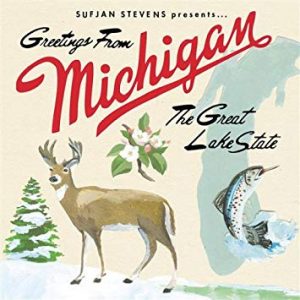
2003's Greetings from Michigan by Sufjan Stevens.
He began this great undertaking with the album Greetings From Michigan: The Great Lake State (also referred to as simply Michigan). The album is Stevens’s first real folk album, as it is dominated by banjo and acoustic guitar and peppered with flutes and dreamy backing vocals, as well as the comforting softness of Stevens’s own voice. The material on Michigan deals mostly with personal experience mixed with poetic imagery and fantastically arranged folk instrumentation, and includes geographic allusions to Detroit, Flint, Ypsilanti, Holland, and the Upper Peninsula, including beautiful scenic imagery mixed with his own personal perspective and voice. The album’s penultimate track, “Redford (For Yia-Yia and Pappou),” is one of those rare instrumental tracks that truly captures the heart, boasting only repetitive, ballet-esque piano chords that tiptoe above a distant-sounding cry. Even if I never know where or what Redford is, I can feel its significance to this one man through this seemingly basic and elementary chord structure.
The following installment in the Project was an album based on the neighboring state of Illinois and is perhaps was his most critically acclaimed album (up until the release of Carrie & Lowell in 2015). Illinois – or Come On Feel the Illinoise! as it is alternately titled – is far less personal than Michigan. According to Stevens, he chose Illinois (namely its specific geography) to explore the state’s split “allegiance”, as southern Illinois leans more towards conservative, traditionally “Southern” ideals, while northern Illinois being more akin to the metropolitan nature of Chicago and its suburbs; and wanted to explore the consequential dissonance that comes from this division as his main interest. Being somewhat unfamiliar with the state, he delved into a four-month long period of non-sto
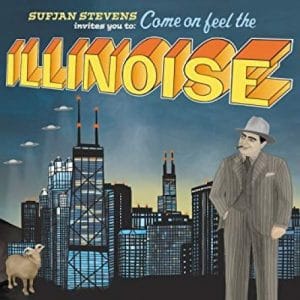
Stevens' Illinois album.
p research, focusing on historical figures, landmarks, and the general lay of the land. The album is chock full of geographically based songs, such as the catchy folksy tune “Jacksonville”, the allusion to the Mississippi Palisades in the “The Predatory Wasp of the Palisades is Out to Get Us,” and the cleverly titled “The Seer’s Tower” in which he incorporates religious imagery within a song about the famous Chicago monument. The album isn’t completely void of personal exposé, as evident in “Decatur, or Round of Applause for your Stepmother!” in which he details a weekend expedition with his own stepmother; and in “Chicago”, a love song that is about a pit stop in Chicago on a trip to New York City. He also dives into a tragic experience—the loss of a dear friend to cancer—in the stripped-down ballad “Casimir Pulaski Day”. There is also a fair amount of allusion to historical figures, with several mentions of Abraham Lincoln, his wife Mary Todd, and an entire song about the famously insane serial killer John Wayne Gacy, Jr. His goal was to avoid a simplistic, historical approach, as he tells Stomp and Stammer: "History on its own, as a series of names and dates, doesn't amount to anything. I think it's important that all things are contextualized and given a place within ourselves and within our imaginations." With Illinois, he succeeds wonderfully in this respect.
" 'It was kind of like a process of psychotherapy, bringing into realization these stories of place and geography and memory...It was definitely accidental, a slow discovery.' "
Since the release of Illinois, there had been many rumors – some started by Sufjan himself – on what his next state project would be. Initially it was Oregon and Rhode Island, and then in an interview with New York Magazine in 2008, he was toying with the idea of New Jersey, namely the Turnpike. Alas, since then, the project has been reportedly abandoned, with Stevens admitting it was a publicity gimmick and “such a joke.” As sad as it is to hear this, it seemed almost inevitable, as the singer was 35 at the time and would have to write, record, and release two albums a year to finish by the time he is 60, which is simply unrealistic.
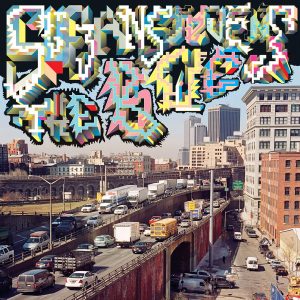
Album cover for Stevens' BQE opus.
However, in 2007, Stevens was commissioned by the Brooklyn Academy of Music (BAM) to do an audio-visual project based on some aspect of New York City. Sufjan’s choice: the Brooklyn-Queens Expressway. For those of you who don’t know, the Brooklyn-Queens Expressway–or BQE, as it is more commonly known–is a twelve-mile urban highway that runs from the RFK Bridge (neé Tri-Borough Bridge) at the top of Queens all the way through Brooklyn to the Verrazano Narrows Bridge at its foot. The highway is constantly packed, riddled with road hazards, and drives even the most calm and reasonable driver to the brink of insanity (I know—I used to drive it all the time). Stevens, on the other hand, finds it to be the perfect subject of his project. “Just living here, I find the BQE is a much more interesting subject because it’s so disliked, yet it’s something you’re forced to deal with in your everyday life in Brooklyn,” he told the NY Press back in 2007. The project began as a film shot on 16mm film, from three different angles to give the illusion of panorama. From here, Sufjan began composing the music, drawing from outside sources, including his parents’ religious background, using its principles to assign symbolism to the BQE. He also drew inspiration from the social issues that it personifies. “For me, the BQE is a tragic object because of how it's displaced people, the way it's an obstacle, the pollution and noise, and the constant upkeep and the traffic and all that,” he told Canada’s Exclaim magazine. “It's a very real, practical problem in my life every day and my way of rendering that through art is to transform it into a fabulous object; into a transcendent, phenomenal experience that's completely unreal, completely artificial.” The album—or “soundtrack”—is written and compiled (and notated in the liner notes) almost like a symphony, with a prelude and postlude, interludes, and several movements, all of which embody a certain facet of the BQE in audible form.
This is one of the reasons this man is one of my heroes: he makes beautiful music based on place and its intersection with personal and interpersonal emotion, though not always those that can be expressed with words. I lived in Brooklyn for several years and the BQE was a thoroughfare that I was all-too-familiar with, especially towards the end of my time there when I would often drive home to CT. On the way home, the BQE was the first hurdle I would encounter, while on the way back to the city it embodied the promise and hope of the proverbial “home stretch.” Most of the time I hated the highway itself; it’s crowded, it’s narrow, it winds unmercifully (especially in Queens), and it is almost always under construction. The last thing I would encounter on the highway (usually) was the Kosciusko Bridge that crosses the creek that separates Brooklyn from Queens, and my exit was the first one after the bridge. There was an awful merge before getting on that bridge because the Long Island Expressway merges with the BQE just north of it, so it was always kind of a mess getting across. I’ve also taken the BQE many times heading south towards Coney Island or Flatbush or Fort Greene, or even to take the Verrazano Narrows Bridge over to Staten Island en route to New Jersey or Philadelphia, and while the view is magnificent along the East River and towards Sheepshead Bay, it was always so nerve-wracking to have to traverse this crazy road. I’ve probably felt every emotion possible driving on this highway, from tranquility all the way to almost uncontrollable rage, and Sufjan’s piece encompasses all these emotions beautifully.
It kind of boggled my mind that someone would want to write an orchestral piece on one of the city’s most hated roadways, but at the same time it seemed so very, very appropriate. So many people use that highway every single day of their lives, and though everyone who utilizes it shares much of their personal experience with those others that drive the road every day, each one is somehow unique. This is where Sufjan shines: he juxtaposes the road’s inherent chaos with the gentle senses of entitlement, privilege, and awe that those who travel on the expressway often cycle through during their morning commute. What Sufjan tried to do was bathe this concrete massacre with some warming facet of humanity. And that he did.
The album, which is sold packaged with the film, is very orchestral and grand, very unlike the BQE. It boasts colorful titles that include symphonic elements (like interludes and movements), such as “Prelude on the Esplanade” and “Movement VI: Isorhythmic Night Dance with Interchanges”, and each of the albums 13 tracks reflect specific times and emotions. There are calm moments on the album, such as the third track “In the Countenance of Kings” (the namesake of which comes from Kings County, the county that Brooklyn fully occupies), but also offers an element of peace, not unlike the rare times the highway is empty (like at 4 AM on a Sunday). “Movement IV: Traffic Shock” perfectly encompasses the hectic and infuriating lack of control one feels while driving on the highway during the day, having to dodge potholes and the numerous inconsiderate drivers that daily populate the busy road, yet shyly undertones the whole experience with the kind of vitality that is rooted deep within the being of each and every New Yorker. It’s an almost jubilant outcry both defacing and embracing the kind of haphazard, invigorating lifestyle all New Yorkers experience daily. Sufjan says the piece is an example of how his work is about nature versus civilization, explaining to Exclaim that “to be a human now in the post-industrial world, is to really reside in the ambiguity of that state of being ― being an organic, natural entity born of the earth but raised in industrial society. A society of products, engineering, and innovation, and our whole world is completely buttressed by these mechanical objects, which allow for the progression of man.”
Stevens’ BQE is a brilliantly beautiful soundtrack to one of the ugliest, most aggravating highways in America. It captures all the essences of this necessary eyesore and makes something truly remarkable out of it. The BQE ties together three of the five boroughs of New York together, like some overwhelmed clogged artery of sorts, but through Stevens’ masterful compositions and his feelings of kinship with his city and its citizens, it is reborn into a symphony.
It just goes to show that beauty is truly in the eyes of the beholder, but in this case, the beholder just wants everyone else to give some things a second glance.

